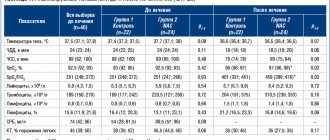Faspik tablets 400 mg No. 6
Compound
1 table contains ibuprofen 400 mg, excipients: L-arginine, sodium bicarbonate, crospovidone, magnesium stearate, hypromellose, sucrose, titanium dioxide, macrogol 400
Pharmacokinetics
Faspik has analgesic, antipyretic, and anti-inflammatory effects.
NSAIDs. Ibuprofen, the active substance of the drug Faspik, is a derivative of propionic acid and has analgesic, antipyretic and anti-inflammatory effects due to the non-selective blockade of COX-1 and COX-2, as well as an inhibitory effect on the synthesis of prostaglandins.
The analgesic effect is most pronounced for inflammatory pain. The analgesic activity of the drug is not of the opioid type.
Like other NSAIDs, ibuprofen has antiplatelet activity.
The analgesic effect when using the drug Faspik develops 10-45 minutes after its administration.
Indications for use
- elevated temperature in various inflammatory diseases
- mild to moderate pain
- rheumatic diseases.
Contraindications
- peptic ulcer of the stomach and duodenum
- attacks of bronchial asthma
- hypersensitivity to the drug, headache, dizziness, blood picture disturbances.
Directions for use and doses
The daily dose of Faspik when taken orally is 0.6-1.2 g in 3-4 doses, the drug is also used rectally in suppositories and externally as an ointment.
Children are prescribed 20-40 mg per kg of body weight per day.
Storage conditions
At a temperature not exceeding 40 C
Best before date
2 years
special instructions
Use with caution in patients with liver and kidney diseases.
Long-term use of Faspik without consulting a doctor is not recommended.
Side effects
- nausea, abdominal pain, bloating, stool disorders
- gastrointestinal bleeding
- renal failure
- abnormal blood picture
- skin rash.
Use during pregnancy and breastfeeding
Contraindicated in children under 12 years of age.
The drug is contraindicated for use during pregnancy and lactation (breastfeeding).
The use of Faspik may adversely affect female fertility and is not recommended for women planning pregnancy.
Interaction
The effectiveness of furosemide and thiazide diuretics may be reduced due to sodium retention associated with inhibition of renal prostaglandin synthesis.
Faspik may enhance the effect of oral anticoagulants, so simultaneous use is not recommended.
When administered simultaneously with acetylsalicylic acid, ibuprofen reduces its antiplatelet effect (an increase in the incidence of acute coronary insufficiency in patients receiving small doses of acetylsalicylic acid as an antiplatelet agent is possible).
Faspik may reduce the effectiveness of antihypertensive drugs.
Isolated cases of increased plasma concentrations of digoxin, phenytoin and lithium while taking ibuprofen have been described in the literature.
Faspik (like other NSAIDs) should be used with caution in combination with acetylsalicylic acid or other NSAIDs and corticosteroids (this increases the risk of adverse effects of the drug on the gastrointestinal tract).
Faspik may increase plasma concentrations of methotrexate.
Combination treatment with zidovudine and Faspic may increase the risk of hemarthrosis and hematoma in HIV-infected patients with hemophilia.
The combined use of Faspic and tacrolimus may increase the risk of nephrotoxicity due to a reduction in PG synthesis in the kidneys.
Ibuprofen enhances the hypoglycemic effect of oral hypoglycemic agents and insulin; dose adjustment may be necessary.
Overdose
Symptoms: abdominal pain, nausea, vomiting, lethargy, drowsiness, depression, headache, tinnitus, metabolic acidosis, coma, acute renal failure, decreased blood pressure, bradycardia, tachycardia, atrial fibrillation, respiratory arrest.
Treatment: gastric lavage (only within an hour after administration), administration of activated charcoal, alkaline drinking, forced diuresis, symptomatic therapy (correction of acid-base status, blood pressure).
Faspik granules for preparation, apricot 400 mg pack 12 pcs
You can minimize the risk of side effects if you take the drug in a short course, at the minimum effective dose required to eliminate symptoms. Elderly people experience an increased incidence of adverse reactions due to the use of NSAIDs, especially gastrointestinal bleeding and perforation, in some cases even fatal.
Side effects are predominantly dose-dependent. In particular, the risk of gastrointestinal bleeding depends on the dose range and duration of treatment.
When using ibuprofen, hypersensitivity reactions have been reported, which may include nonspecific allergic reactions and anaphylactic reactions, respiratory reactions - asthma, incl. its exacerbation, bronchospasm, shortness of breath, skin reactions - itching, urticaria, Quincke's edema, less often exfoliative and bullous dermatoses, including toxic epidermal necrolysis and erythema multiforme.
The following reactions were observed with short-term use of ibuprofen in doses not exceeding 1200 mg/day (6 packets of 200 mg or 3 packets of 400 mg). When treating chronic conditions and with long-term use, other adverse reactions may occur. The frequency of adverse reactions was assessed based on the following criteria: very common (> 1/10); frequent (from > 1/100 to 1/1000 to 1/10000 to
Immune system disorders: uncommon: hypersensitivity reactions manifested by urticaria and itching; very rare: in patients with autoimmune disorders (systemic lupus erythematosus, mixed connective tissue disease) during treatment with ibuprofen, isolated cases of symptoms of aseptic meningitis were observed, in particular, stiff neck, headache, nausea, vomiting, fever, disorientation. Severe hypersensitivity reactions. Symptoms may include swelling of the face, tongue, and larynx, shortness of breath, tachycardia, and hypertension (anaphylaxis, angioedema, or severe anaphylactic shock). Exacerbation of bronchial asthma and bronchospasm.
Gastrointestinal disorders: uncommon: abdominal pain, nausea, dyspepsia, gastritis, bloating; rare: diarrhea, flatulence, constipation, vomiting; very rare: peptic ulcer, perforation or gastrointestinal bleeding, melena, hematemesis, in some cases fatal, especially in elderly patients, ulcerative stomatitis, exacerbation of colitis and Crohn's disease.
Disorders of the urinary system and liver: very rare: liver dysfunction (especially with long-term treatment), hepatitis and jaundice, renal failure (compensated and decompensated), interstitial nephritis, nephritic syndrome, papillonecrosis, especially with long-term use, in combination with increased serum urea levels and the appearance of edema, hematuria and proteinuria.
Nervous system disorders: uncommon: dizziness, headache; very rare: aseptic meningitis, stroke.
Mental disorders: very rare: nervousness.
Sensory organ disturbances: very rare: visual disturbances, ringing or tinnitus.
Cardiovascular system disorders: very rare: heart failure, hypertension.
Disorders of the respiratory system and mediastinal organs: very rare: bronchial asthma, bronchospasm, shortness of breath and wheezing.
Skin and subcutaneous tissue disorders: uncommon: various types of skin rashes; very rare: severe forms of skin reactions, including Stevens-Johnson syndrome, erythema multiforme and toxic epidermal necrolysis.
General disorders at the injection site: very rare: swelling, incl. peripheral.
Laboratory parameters: - hematocrit or hemoglobin (may decrease); - bleeding time (may increase); - serum glucose concentration (may decrease); - creatinine clearance (may decrease); - serum creatinine concentration (may increase); - activity of “liver” transaminases (may increase).
If side effects occur, you should stop taking the drug and consult a doctor.
Faspik granules for preparing a solution with mint flavor 200 mg 3 g 12 pcs
The effectiveness of furosemide and thiazide diuretics may be reduced due to sodium retention associated with inhibition of renal prostaglandin synthesis. Strengthens the effect of indirect anticoagulants, antiplatelet agents, fibrinolytics (increasing the risk of hemorrhagic complications). When administered simultaneously with acetylsalicylic acid, ibuprofen reduces its antiplatelet effect (possibly increasing the incidence of acute coronary insufficiency in patients receiving small doses of acetylsalicylic acid as an antiplatelet agent). Reduces the hypotensive activity of vasodilators (including slow calcium channel blockers and ACE inhibitors). Isolated cases of increased plasma concentrations of digoxin, phenytoin and lithium while taking ibuprofen have been described in the literature. Agents that block tubular secretion reduce excretion and increase plasma concentrations of ibuprofen. Faspik (like other NSAIDs) should be used with caution in combination with acetylsalicylic acid or other NSAIDs (this increases the risk of adverse effects of the drug on the gastrointestinal tract). Faspik may increase plasma concentrations of methotrexate. Combination treatment with zidovudine and Faspic may increase the risk of hemarthrosis and hematoma in HIV-infected patients with hemophilia. The combined use of Faspic and tacrolimus may increase the risk of nephrotoxicity due to a reduction in the synthesis of prostaglandins in the kidneys. Ibuprofen enhances the hypoglycemic effect of oral hypoglycemic agents and insulin; Dose adjustment may be necessary. An ulcerogenic effect with bleeding has been described when combined with colchicine, estrogens, ethanol, and glucocorticosteroids. Antacids and cholestyramine reduce the absorption of ibuprofen. Caffeine enhances the analgesic effect. When prescribed with anticoagulant and thrombotic agents (alteplase, streptokinase, urokinase), the risk of bleeding simultaneously increases. Cefamandole, cefaperazone, cefotetan, valproic acid, plicamycin increase the incidence of hypoprothrombinemia. Myelotoxic enhance the manifestations of hematotoxicity of the drug. Cyclosporine and gold preparations enhance the effect of ibuprofen on the synthesis of prostaglandin in the kidneys, which is manifested by increased nephrotoxicity. Ibuprofen increases the plasma concentration of cyclosporine and the likelihood of developing its hepatotoxic effects. Inducers of microsomal oxidation (phenytoin, ethanol, barbiturates, rifampicin, phenylbutazone, tricyclic antidepressants) increase the production of hydroxylated active metabolites, increasing the risk of severe hepatotoxic reactions. Microsomal oxidation inhibitors reduce the risk of hepatotoxicity.
Faspik
The effectiveness of furosemide and thiazide diuretics may be reduced due to sodium retention associated with inhibition of renal prostaglandin synthesis. Strengthens the effect of indirect anticoagulants, antiplatelet agents, fibrinolytics (increasing the risk of hemorrhagic complications). When administered simultaneously with acetylsalicylic acid, ibuprofen reduces its antiplatelet effect (possibly increasing the incidence of acute coronary insufficiency in patients receiving small doses of acetylsalicylic acid as an antiplatelet agent). Reduces the hypotensive activity of vasodilators (including slow calcium channel blockers and ACE inhibitors). Isolated cases of increased plasma concentrations of digoxin, phenytoin and lithium while taking ibuprofen have been described in the literature. Agents that block tubular secretion reduce excretion and increase plasma concentrations of ibuprofen. Faspik (like other NSAIDs) should be used with caution in combination with acetylsalicylic acid or other NSAIDs (this increases the risk of adverse effects of the drug on the gastrointestinal tract). Faspik may increase plasma concentrations of methotrexate. Combination treatment with zidovudine and Faspic may increase the risk of hemarthrosis and hematoma in HIV-infected patients with hemophilia. The combined use of Faspic and tacrolimus may increase the risk of nephrotoxicity due to a reduction in the synthesis of prostaglandins in the kidneys. Ibuprofen enhances the hypoglycemic effect of oral hypoglycemic agents and insulin; Dose adjustment may be necessary. An ulcerogenic effect with bleeding has been described when combined with colchicine, estrogens, ethanol, and glucocorticosteroids. Antacids and cholestyramine reduce the absorption of ibuprofen. Caffeine enhances the analgesic effect. When prescribed with anticoagulant and thrombotic agents (alteplase, streptokinase, urokinase), the risk of bleeding simultaneously increases. Cefamandole, cefaperazone, cefotetan, valproic acid, plicamycin increase the incidence of hypoprothrombinemia. Myelotoxic enhance the manifestations of hematotoxicity of the drug. Cyclosporine and gold preparations enhance the effect of ibuprofen on the synthesis of prostaglandin in the kidneys, which is manifested by increased nephrotoxicity. Ibuprofen increases the plasma concentration of cyclosporine and the likelihood of developing its hepatotoxic effects. Inducers of microsomal oxidation (phenytoin, ethanol, barbiturates, rifampicin, phenylbutazone, tricyclic antidepressants) increase the production of hydroxylated active metabolites, increasing the risk of severe hepatotoxic reactions. Microsomal oxidation inhibitors reduce the risk of hepatotoxicity.

